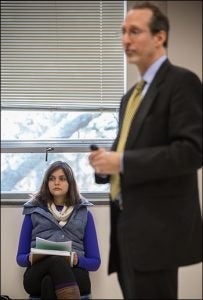IN-CLASS AID
ECU embedded tutors assist a wide variety of learners
A select group of tutors at East Carolina University are now embedded in eight key college courses to provide a tutoring experience that reaches a greater number of students and is more meaningful to both faculty members and struggling students.
Embedded tutors at ECU are possible through a grant from College STAR (Supporting Transition, Access and Retention) – a UNC-system project designed to support students with learning differences. The grant, however, makes the tutoring services available to everyone in the class, not just those with identified disabilities.
The tutors receive training in learning theory, learning differences and use of assistive technologies. This tutoring approach brings support to both students and faculty as well as leadership opportunities to participating tutors.
The eight courses selected for embedded tutors are ones deemed essential to a student continuing in a particular course of study. Tutor Brianna Horne, a sophomore from Williamston, is embedded in the first chemistry course required for students planning a career in nursing. She partners with professor David Bjorkman, attends the class herself and offers workshops and test preparation to everyone in the class.
“I try to put myself in the place of a student who may be struggling, “ she said. “I know how that feels.”
Horne uses a Thinkpad in both one-on-one and large format tutoring sessions. By connecting the iPad to an LCD monitor, she does not need to hover over her tutees but can remain seated – maintaining an equal relationship and status during a tutoring session.
“Microsoft’s OneNote changes the dynamics of tutoring,” agreed Evan Arthur, a senior tutor from Huntersville. “Students are relieved after learning they don’t have to frantically write down notes because I can send them notes from our session. It makes the experience much more interactive and valuable.”
In addition, Horne and Arthur use Tegrity lecture capture software to allow their tutoring workshops to be recorded and viewed as many times as needed by students. They can also be shared with those unable to attend a review session in person, including distance education students. Grant funding helped pay for those technology purchases, and also pays tutor salaries.
Elizabeth Coghill, director of the Pirate Tutoring Center, explained that the combination of embedded tutors and using technology to enhance tutoring has resulted in tutoring sessions that are beneficial to a wider audience.
“Because our tutors are using videos and electronic note capturing systems, their help is available at all hours benefitting those with non-traditional class schedules as well as those who are juggling a job or a family,” she said.
Subodh Dutta, a faculty member who teaches introductory chemistry, has two embedded tutors and meets with them weekly. “We review what I will be covering and the main things to emphasize in follow-up sessions,” he said.
Dutta said his students can learn valuable study skills from the tutors as well as benefit from knowing that they can get help when they need it. “I have 500 students and there is no way I can personally interact with everyone,” he said.
Coghill said more than 1,100 students viewed tutoring content about 8,000 times during the fall semester. More than 900 students attending classes with embedded tutors took advantage of the extra help offered.
Tutoring is not only available for entry-level courses. John Kerbs, associate professor in criminal justice, partners with a crew of tutors to support students taking an upper level statistics course that is required for students majoring in criminal justice.
“These are students who are planning to be practitioners in the law enforcement, court and correctional systems,” Kerbs said, “Numbers may not be their thing and statistics can be very scary.”
Kerbs worked with lead tutor Ethan Cooper, a senior from Goldsboro, who developed review slides that are readily available to all students on-line. “We discovered that one barrier to success in our statistics course was that some students struggled with some of the basic math skills required to thrive in upper-level courses,” Kerbs said. “So Mr. Cooper developed a remediation workshop for algebra that students can take in the first two weeks of the course.”
Kerbs is actively engaged with his tutoring team and believes it is important to have a diverse tutoring workforce to match a diverse student body. “I want all students to find tutors that they can relate to and feel comfortable with,” he said.
Kerbs and Cooper will be sharing their experiences in February at the annual meeting of the Academy of Criminal Justice Sciences. Coghill recently shared the ECU experience with embedded tutors and technology at a summit for educators across the state sponsored by the College Reading and Learning Association. She said the support of the foundations that fund College STAR has been invaluable to the embedded tutor program.
“We are currently studying the effectiveness of the model and tracking student usage and course grades,” Coghill said. “I hope to have the ability to expand to other course sections as funding allows.”
ECU is the first university in the UNC-system to experiment with embedded tutors. The grant will fund two more years of the program.
College STAR is currently funded by the Oak Foundation of Geneva, Switzerland, and the N.C. GlaxoSmithKline Foundation.
###
Kathryn Kennedy of ECU News Services contributed to this article.
with Embedded TutorsChemistry 2750 (organic)
Chemistry 1120
Chemistry 1130 (nursing chemistry)
Criminal Justice 3900
Psychology 3310
Psychology 3326
Prior Courses
with Embedded Tutors
Biology 2150
English 1100
Math 1050
Psychology 1000
Psychology 3312
Sociology 2110

Embedded tutor Jennifer Violette listens in during a criminal justice class taught by ECU professor John Kerbs, standing. (Photo by Cliff Hollis)